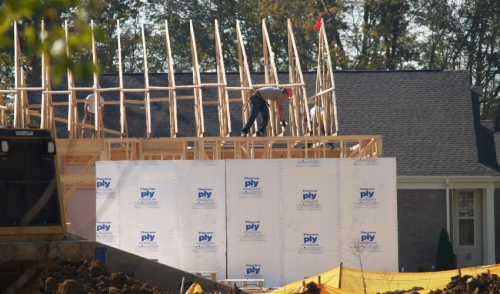
{article.name}
Social Media Links
Lack of Permit Could Come Back to Haunt

- Share this:
- Share on Facebook
- Pin on Pinterest
- Tweet on Twitter
Ron Roen had a problem. He wanted to put his Bellevue, Wash., home on the market and move to a house on the water. But inspection of the roof in the course of preparing the house for sale revealed numerous code violations including lack of ice-and-water shield, improper chimney flashing, and valleys covered by shingles. The sales process halted.
It turns out that C&S Roofing, the company that Roen hired in 2009 to re-shingle his roof, never pulled a permit. Contacted by a local news crew, C&S Roofing owner Shane Dupius said: “Some mistakes were made and subcontractors did the work.” He promised to have a crew out to the house within 24 hours. Sure enough, they were there. This time C&S Roofing pulled the permit.
By the Book
Permits are issued to ensure that a building under construction or undergoing renovation is built according to current local and state code standards. That is, that the construction and what results is legal and safe. “Building permits are required for most construction or remodeling projects to ensure the safety of the structure,” notes construction legal website Nolo. “Some common exceptions include the construction of small detached buildings (such as storage sheds), certain fences and retaining walls, driveways, window replacements, painting, floor coverings, and certain roofing repairs or replacements.”
Not every locale requires permits for roof replacement, but many do. Philadelphia, for instance, requires permits, but not plans.
But just because they’re required doesn’t mean that the necessary permit or permits will be pulled. “Because of the cost involved and apprehension of working with the government, some homeowners are tempted to not get the proper permits for a home remodel. That is not a good idea,” note Annie Schwemmer and Ann Robinson in a recent series in the Deseret News, of Salt Lake City.
In fact, it would not be a good idea, under most circumstances, for a homeowner to pull a permit. “I cringe when I hear that a homeowner has pulled a building permit,” writes attorney Andrea Goldman on her blog. “Homeowners do not consider the responsibility that goes along with pulling the permit and do not really think things through before doing so.” She proceeds to list the reasons. A homeowner who pulls his own permit is liable if anyone is hurt doing the work, if the work somehow damages his or a neighbor’s property, and is wholly responsible if the work isn’t up to code. In short, think of that old saw about the attorney who chooses to represent himself having a fool for a client. Ditto homeowners and permits.
Contractor’s Responsibility
In most cases, however, it is the general contractor on the job who is responsible for submitting building plans to the local municipality’s code-compliance department, obtaining required permits and scheduling intermediate and final inspections before the work begins. Once permits are pulled, it’s also the contractor’s responsibility to redo work that fails inspection. “Permits require a code-enforcement inspector to sign off on work at various stages, depending on the type of project,” explains Angie Hicks on the Angie’s List website. “That provides assurance that the framing, plumbing, electrical or other work meets code. Also, a lack of required permits may affect your home’s insurance coverage.” That is, if no permit was pulled on the roofing work, and a claim is at some point filed with the company that wrote the homeowners’ insurance policy because for any reason the roof failed, the insurer is perfectly within its rights to deny the claim.
In many cases, a city or other entity can order work done without required permits to be redone. That is, rip it out or off and start over.
Staring at the Stars
Given the various hassles that can result from failure to pull required permits, why would a contractor not do it?
There are several reasons. One is that he may not be licensed in a state or locality that requires licensing. Or, it may be that his installation practices routinely ignore code and he simply doesn’t want to get flagged in an inspection. Take the contractor who, instead of venting a bathroom fan outside, as code requires, routinely vents it into the attic (where warm, moist air will, in time, wreak havoc on framing).
And then there are those who think they won’t get caught or reported for failing to get necessary and required permits. (Often they’re right.) Money is another reason. In some townships or cities, pulling a roof permit can add hundreds of dollars to the cost of a re-roof, and if competitors don’t bother, you’re already adding that much more cost to the job that makes their price less than your own. In fact, according to information at Home Advisor, “the national average cost of a building permit is $979, with most homeowners spending between $398 and $1,561. This data is based on actual project costs according to HomeAdvisor members.”
In roofing, the issue can come down to time. Pulling a permit and awaiting the necessary inspection from municipal authorities are steps that delay moving forward with a job that—say we’re talking about re-shingling—will take two or three days, with crews efficiently managed. If the roof holds up, who’s going to notice?
To that last question, the answer is: It depends on where you are. Someone might, and then you’ll wish you had pulled the permit, whatever the hassle, cost, or delay. Because “… what happens when a city inspector drives by your home, stops to check that a permit for the roofing work is posted onsite, and there’s no permit to be found?” Signature Roofing, in San Mateo, Calif., asks on its website. “The inspector can immediately shut down all roofing work and send the roofers packing until a permit is issued.” Not only that, Signature Roofing points out, but if that inspector stops by at the point where the roofing tear-off has just been completed, “you could be left staring at the stars right from your bed.” In which case, it's best to tarp that bed, if rain’s in the forecast.
Current Owner Must Be Compliant
But even if none of that took place; if inspectors were evaded and a re-roofing job was completed without permit in a locale that required it, the roofing company may have gotten away with something … until word got around. For the homeowner, though, there could well be trouble down the road. Ask
Ron Roen.
Disclosure statements that sellers fill out ask about renovations to the house, and whether or not permits were required, and drawn, for said renovations. Because what happens is that, once the house is sold, the current owner of the property becomes responsible. “The current owner can be faced with additional fines and liens on their property if they do not resolve all issues and satisfy the permit requirements,” notes CPM Inspections, a real estate inspection service. “Some property owners find it cheaper and easier to remove the addition or renovation and start from scratch with an Architect or General Contractor. Some people have recently had to have a brand new roof removed and replaced because the contractor did not pull a permit and have proper inspections.”
Ron Roen may be aggravated by what he had to go through to put his house on the market, but he was lucky that the company that did the re-roofing was still in business. "I'm impressed with the response from C&S Roofing to come out and make things right," he told Channel 6 News, in Bellevue. He should be.
This article was originally posted on ProremodelerTo view this article in its original form, Click Here!
Sign up for our Email List
Stay updated with all our latest posts, products and offers! Just enter your information below.

Comments